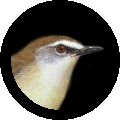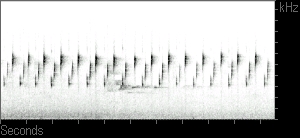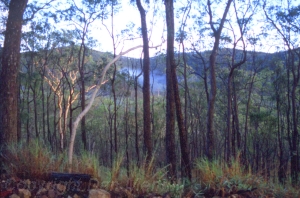 Brown Gerygone
Brown Gerygone
Gerygone mouki
 Figure 1. Spectrogram of the
Brown Gerygone song.
Figure 1. Spectrogram of the
Brown Gerygone song. (The first 10-seconds from the sound file are depicted.)

Brown Gerygone - Gerygone mouki
Brown gerygones will win no prizes as songsters. However, what they lack in musicality they compensate for in endurance; brown gerygones repeat the same three-syllable motif over and over ad infinitum. Their songs are composed of three or four noisy syllables which rise in frequency from 3000 to 6000 Hz, sounding like ‘which-is-it? which-is-it? which-is-it?’. Brown gerygones repeated this three-note motif at a rate of one motif every 0.6 seconds. Song bouts may last for several minutes.
Brown gerygones travel in chattery groups through the rainforest understory. They build covered nests with long tapering tails made from spider webs, plant shoots, moss and lichen. Gerygone nests are popular day-roost sites for the golden-tipped bat, Kerivoula papuensis.
Habitat.
Brown gerygones are found in the thickest parts of rainforests, coastal forests, and mangroves.
Range.
Three disjoint races of brown gerygone are found along the eastern coast of Australia. The race G. m. mouki lives in the forests of northeastern Australia around the Atherton Tablelands.
Further Reading.
M. Schultz. 2000. Roosts used by
the golden-tipped
bat Kerivoula papuensis. Journal of Zoology. 250: 467-478.
No recordings, photographs, or other information may be used without written permission (email me at dmennill AT uwindsor DOT ca).